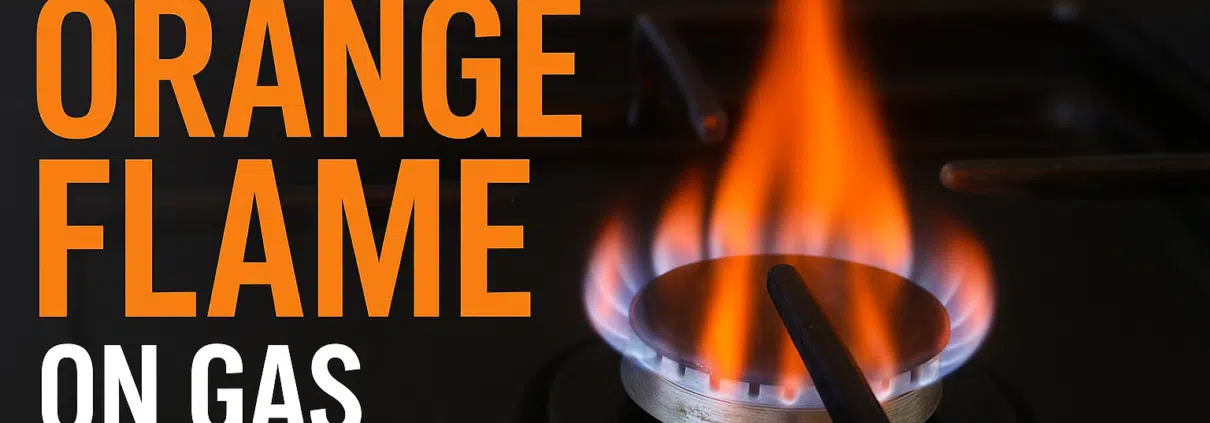If you see a steady blue flame when you turn on your gas range. That is the normal color of a gas stove flame, indicating that the gas is burning effectively with the proper ratio of oxygen to gas. A stove flame that appears orange, yellow, or flickers between orange and blue indicates incomplete combustion, which can occasionally be dangerous.
In this guide, we will discuss what causes an orange flame on a gas stove, how to safely fix it, and when to call in a professional Appliance Repair in Edmonton.
Is Orange Flame on a Gas Stove Dangerous?
Yes. A persistent orange flame indicates that your stove is not burning fuel correctly and is not just a decorative problem. This may result in the following:
- The formation of carbon monoxide (CO), an odorless, colorless gas that is harmful if inhaled.
- Black residue on cookware and adjacent surfaces is known as smoke buildup.
- Less efficiency: gas is wasted, and food takes longer to cook.
Stop using the stove, air out your kitchen, and ensure your CO detector is operational. If you see orange flames on all the burners, see ash, or smell gas, take immediate action.
Why Does My Gas Range Flame Turn Orange?
Several issues can cause an orange or yellow flame:
- Clogged burner ports: The gas flow may be obstructed by spills, grease, or food particles.
- Blocked venture tubes or air intakes: debris, oil, or even insect webs can obstruct airflow.
- Misaligned burner caps: Flames won’t burn evenly if the caps aren’t seated flat.
- Incomplete conversion or incorrect fuel: An orange flame may result from a natural gas stove that is powered by propane (or vice versa) without the necessary conversion.
- Cookware flame impingement: the flame may turn orange if pans are positioned too low or obstruct airflow.
- Dust or sodium contamination: flames may temporarily appear orange following cleaning or cooking with salty meals.
- Ventilation issues: inadequate airflow around the range lowers oxygen levels.
- Is the gas stove’s humidifier producing an orange flame? Orange flames are rarely caused by household humidity alone. However, insufficient ventilation and excessive moisture can exacerbate combustion issues.
How to Fix an Orange Flame on a Gas Stove
Follow these safe troubleshooting steps before calling a technician:
Check Flame Appearance
- A normal gas stove flame color is blue, with maybe a tiny blue tip.
- A continuous orange or yellow flame (especially if it leaves soot) indicates a problem.
Remove Cookware and Foil Liners
- Make sure nothing is obstructing the flame.
- Remove oversized pans, foil liners, or anything that interferes with airflow.
Clean the Burners
- Take off the burner heads and caps, if your model permits, by cutting of the gas.
- Clean with warm, soapy water; clean burner ports with a toothpick or soft brush.
- Before reassembling, allow everything to completely dry.
- Verify that burner caps are seated and positioned correctly.
Inspect Air Inlets
- Check the small openings near the burner (venturi tubes/air holes).
- Use a soft brush to clean away grease or debris.
Test the Flame Again
- If you see a blue flame after re-lighting the burner, the issue may have been simple debris or misalignment.
Call a Professional if the Problem Persists
If you still see an orange flame on all burners, it could mean:
- Incorrect air shutter settings
- Faulty regulator or gas pressure issues
- Wrong fuel type (natural gas vs propane)
- High altitude installation without modification
These issues should only be fixed by a licensed technician.
Orange and Blue Flame on Gas Stove – Is It Normal?
Sometimes you may see a mix of orange and blue flames. Brief orange tips after cleaning, cooking salty food, or initial ignition can be normal. The flame should stabilize to mostly blue after a few minutes.
If the orange persists, or if you see soot, treat it as a sign of incomplete combustion.
Safety Tips
- Always keep a carbon monoxide detector in or near your kitchen.
- Never try to adjust gas pressure or regulators yourself—this is a job for a professional.
- Schedule regular maintenance if you rely heavily on your gas range.
Conclusion
An orange flame on your gas stove is a warning sign that should not be ignored. While simple cleaning and burner inspection often fix the problem, persistent orange or yellow flames—especially on all burners—mean you should call a qualified technician.
By knowing the normal gas stove flame color (blue), you can quickly spot when something’s wrong and take steps to keep your home safe.




Leave a Reply
Want to join the discussion?Feel free to contribute!